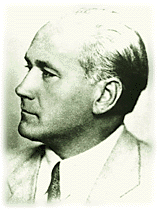|
KÁLMÁN TIHANYI (1897 - 1947) |
 |
Born in Uzbeg, he studied electrical engineering and physics in Pozsony and Budapest. His most important inventions - bought and developed by RCA, Loewe, and Fernseh AG - concerned the design of the cathode ray tube for television.
He patented his fully electronic television system in 1926. Though superficially similar to such earlier proposals, it represented a radical departure. Like the final, improved version he would patent in 1928, it embodied a new concept in design and operation, building upon a phenomenon that would become known as the "storage principle".
The invention was received with enthusiasm by Telefunken and Siemens, but in the end they opted for continued development of mechanical television.
RCA approached Tihanyi in 1930, after the publication of his patents in England and France. Negotiations continued until 1934, when RCA, ready to unveil its new television system based on Tihanyi's design, purchased his patents. These covered controlling features that the U.S. patent examiners, citing Tihanyi's prior publications, had denied Zworykin's 1930 - 31 applications. U. S. patents assigned to RCA were issued to Tihanyi in 1938-39 with 1928 priority. Now it is becoming increasingly obvious that the originator of this pivotal invention was Kalman Tihanyi.
From 1929, he worked on television-guidance for defense, building prototypes of his robot aircraft in London for the British Air Ministry, later adapting it for the Italian Navy. In 1935-1940, he completed plans for an Ultrasound Radiator - with a projection range of up to 8 km - and in 1940, he returned to Hungary where he built its prototype.
Television (1926, 1928)
The idea to utilize the cathode ray tube as image converter on the side of transmission surfaced in 1908, and was described in detail by A. A. Campbell Swinton in a paper he published in 1911. In the 1920's variations on the Campbell Swinton design were proposed by Zworykin, Schoultz, Sabbah, et. al. All were electrical analogues of mechanical scanners, in that electron emission would occur only during the momentary contact by the scanning ray of each elemental area of the photocell. In 1925 a demonstration by Zworykin with his system produced discouraging results.
The decisive solution - television operating on the basis of continuous electron emission with accumulation and storage of released secondary electrons during the entire scansion cycle - was first described by Kálmán Tihanyi in 1926, with further refined versions patented by him in 1928.

